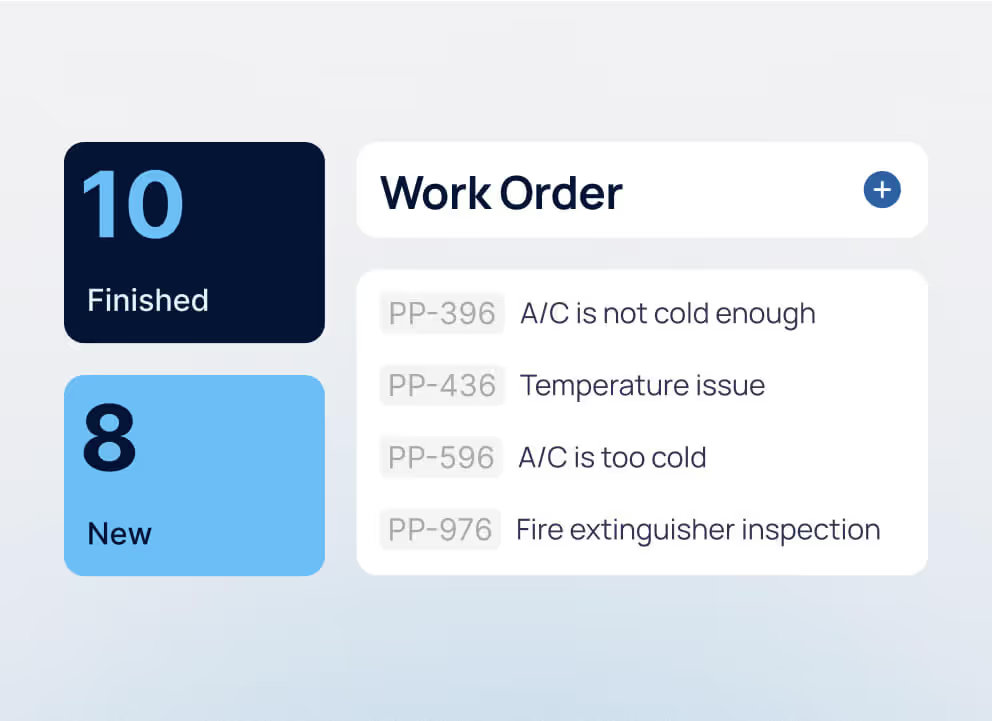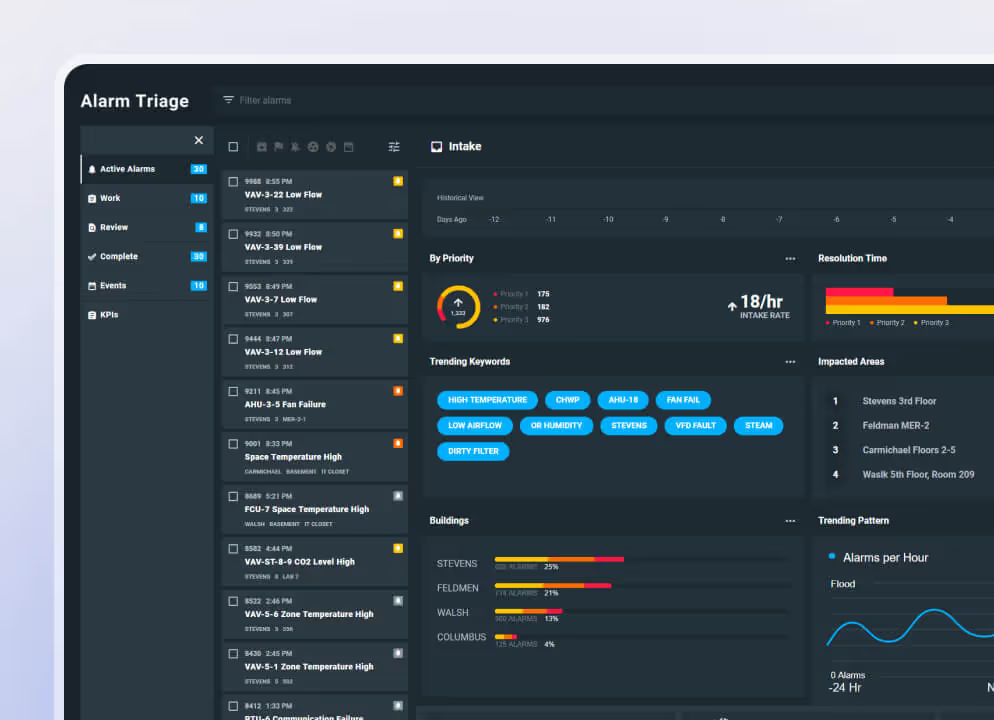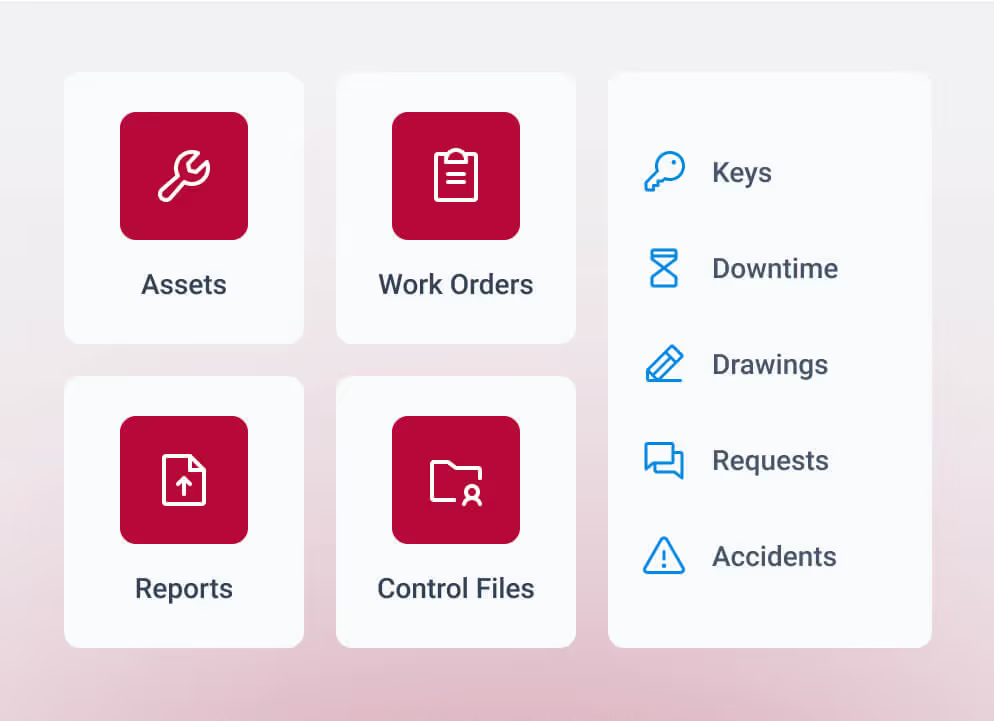Benefits of Predictive Maintenance and Preventive Maintenance
Benefits of Predictive Maintenance and Preventive Maintenance
In this post
%20(1).avif)
1
2
3
Benefits of Predictive Maintenance and Preventive Maintenance
Both predictive and preventive maintenance approaches are crucial to improving equipment reliability, increasing operational efficiency, minimizing downtime, and reducing costs.
The operational efficiency of an enterprise squarely depends on the performance of all the equipment in its facility. This is why enterprise asset management (EAM) is critical – it ensures that every component of the infrastructure is functioning at its highest level. There are various maintenance management practices, and selecting the best one is the key to maximizing productivity and asset longevity while minimizing total cost of ownership (TCO). Generally, predictive maintenance and preventive maintenance are the most preferred methods.
What is predictive maintenance?
Predictive maintenance is a data-driven strategy that focuses on maintaining the health of assets by analyzing and utilizing collected data intelligently. Rather than relying on fixed schedules, this approach determines when services and repairs should be performed based on an asset's failure to meet prescribed performance objectives.
What is preventive maintenance?
Preventive maintenance is a proactive approach that involves regularly scheduled tasks and inspections to prevent equipment and machinery from breaking down or experiencing unexpected failures. This method follows a predetermined schedule based on historical data, manufacturer recommendations, and industry best practices.
How does predictive maintenance work?
Predictive maintenance utilizes data analysis, machine learning, and condition monitoring to predict equipment failures before they occur. Through the collection of relevant data from sensors and IoT devices, the information undergoes preprocessing to remove noise and inconsistencies. Continuous condition monitoring allows for real-time tracking of equipment health and performance. Analyzing historical data and leveraging machine learning models, software can detect of patterns and anomalies. This helps predict potential faults and estimate remaining useful life. When critical thresholds are identified, alerts and notifications are sent to maintenance personnel, enabling them to plan and schedule preemptive maintenance.
How does preventive maintenance work?
Preventive maintenance involves scheduled maintenance tasks aimed at preventing equipment failures and ensuring consistent performance. Based on manufacturer recommendations, industry standards, and historical maintenance data, teams perform regular inspections, and other maintenance activities, including lubrication, parts replacement, and cleaning. These tasks are performed at predetermined intervals, often following a calendar-based or usage-based schedule. By adhering to preventive maintenance schedules, organizations aim to minimize the likelihood of unexpected breakdowns, extend equipment lifespan, and optimize operations.
Difference between predictive maintenance and preventive maintenance
While both predictive and preventive maintenance aim to protect equipment, their approaches differ. Some critical differences between preventive and predictive maintenance:
Predictive Maintenance vs Preventive Maintenance
What are the benefits of predictive maintenance and preventive maintenance?
Both predictive maintenance and preventive maintenance are important parts of facility maintenance management. Using preventive maintenance along with a predictive maintenance strategy, your enterprise can:
- Improve overall operational efficiency and minimize disruptions to workflow by addressing potential equipment issues before they escalate.
- Enhance safety measures for personnel and mitigate the risks associated with sudden equipment failures or malfunctions.
- Optimize inventory management through better planning and forecasting of spare parts, reducing inventory carrying costs.
- Facilitate data-driven decision-making by leveraging real-time equipment health information and historical performance data.
- Establish a preemptive maintenance approach, fostering a culture of continuous improvement and equipment reliability within the organization.
Five reasons why your facility needs predictive maintenance and preventive maintenance:
- Cost savings
- Maximizes efficiency
- Prolongs equipment life
- Reduces maintenance costs
- Improves safety and reliability
Implementing a successful predictive or preventive maintenance program
- Assess your facility’s critical equipment and machinery that could benefit from predictive and preventive maintenance.
- Gather relevant historical data to establish baseline performance metrics and failure patterns. Acquire or install appropriate sensors and monitoring systems to continuously collect real-time data from the equipment.
- Employ advanced analytics and machine learning techniques to predict potential failures and schedule maintenance proactively. Regularly update and refine the predictive models to ensure accuracy and effectiveness.
- Foster a culture of collaboration between maintenance and operations teams to optimize the program’s efficiency and overall success.
Examples of predictive maintenance and preventive maintenance across industries
- Manufacturing – Help prevent unexpected breakdowns and optimize production schedules.
- Transportation and logistics – Ensure timely vehicle maintenance, improving safety and efficiency.
- Energy sector – Monitor critical assets and optimize energy consumption.
- Healthcare - Enhance medical equipment reliability, ensuring better patient care.
Combining predictive and preventive maintenance with CMMS software solutions
A central repository for maintenance data, a CMMS enables easier data collection and management. By integrating predictive and preventive maintenance insights with CMMS, maintenance teams can prioritize, and schedule tasks based on predicted failure probabilities, ensuring resources are allocated efficiently. Real-time sensor data can trigger automatic work orders, warranting rapid response times. CMMS analytics can track the effectiveness of the predictive and preventive maintenance program and identify areas for improvement, leading to continuous optimization.
Future of predictive maintenance and preventive maintenance
The future of predictive and preventive maintenance is promising, driven by key trends and innovations. Artificial Intelligence (AI) and Machine Learning (ML) algorithms will become more advanced, enabling even more accurate predictions. Predictive maintenance will further integrate with the Internet of Things (IoT) and Industry 4.0, allowing interconnected systems to optimize performance. Overall, the future will witness an evolution of predictive maintenance and preventive maintenance into a highly efficient, proactive, and indispensable practice across industries.
Optimizing facility maintenance management with TMA Systems
Predictive maintenance and preventive maintenance have transformed how industries manage maintenance and operations. With careful planning, investment in the right tools, and a commitment to training, any implementation challenges can be overcome.
These predictive and preventive maintenance techniques are strengthened by TMA Systems’ solution, WebTMA. The flexible platform centralizes your database of asset information, maintenance history, vendor data, manuals, work order history and more. Easily capture, manage, and report on this data. Facility managers have the information and control they need to make intelligent, timely decisions that drive asset performance, reliability, and safety.
WebTMA seamlessly integrates with your legacy software providing you with the power to increase productivity with a strategic predictive and preventive maintenance plan.
Schedule a demo to learn more about how WebTMA can help transform your predictive maintenance and preventive maintenance efforts, supporting your team with actionable data and insights.
- Extend asset life and lower repair costs through consistent, preventive care.
- Avoid expensive disruptions with proactive maintenance strategies.
- Boost reliability by making smarter use of your maintenance data.

Download the eBook now
You’re all set!
Your eBook is on its way to your inbox. We hope it brings fresh insights and practical takeaways to help you get more from your maintenance operations.
Explore related resources
.avif)
.svg)
Benefits of Predictive Maintenance and Preventive Maintenance
Both predictive and preventive maintenance approaches are crucial to improving equipment reliability, increasing operational efficiency, minimizing downtime, and reducing costs.
The operational efficiency of an enterprise squarely depends on the performance of all the equipment in its facility. This is why enterprise asset management (EAM) is critical – it ensures that every component of the infrastructure is functioning at its highest level. There are various maintenance management practices, and selecting the best one is the key to maximizing productivity and asset longevity while minimizing total cost of ownership (TCO). Generally, predictive maintenance and preventive maintenance are the most preferred methods.
What is predictive maintenance?
Predictive maintenance is a data-driven strategy that focuses on maintaining the health of assets by analyzing and utilizing collected data intelligently. Rather than relying on fixed schedules, this approach determines when services and repairs should be performed based on an asset's failure to meet prescribed performance objectives.
What is preventive maintenance?
Preventive maintenance is a proactive approach that involves regularly scheduled tasks and inspections to prevent equipment and machinery from breaking down or experiencing unexpected failures. This method follows a predetermined schedule based on historical data, manufacturer recommendations, and industry best practices.
How does predictive maintenance work?
Predictive maintenance utilizes data analysis, machine learning, and condition monitoring to predict equipment failures before they occur. Through the collection of relevant data from sensors and IoT devices, the information undergoes preprocessing to remove noise and inconsistencies. Continuous condition monitoring allows for real-time tracking of equipment health and performance. Analyzing historical data and leveraging machine learning models, software can detect of patterns and anomalies. This helps predict potential faults and estimate remaining useful life. When critical thresholds are identified, alerts and notifications are sent to maintenance personnel, enabling them to plan and schedule preemptive maintenance.
How does preventive maintenance work?
Preventive maintenance involves scheduled maintenance tasks aimed at preventing equipment failures and ensuring consistent performance. Based on manufacturer recommendations, industry standards, and historical maintenance data, teams perform regular inspections, and other maintenance activities, including lubrication, parts replacement, and cleaning. These tasks are performed at predetermined intervals, often following a calendar-based or usage-based schedule. By adhering to preventive maintenance schedules, organizations aim to minimize the likelihood of unexpected breakdowns, extend equipment lifespan, and optimize operations.
Difference between predictive maintenance and preventive maintenance
While both predictive and preventive maintenance aim to protect equipment, their approaches differ. Some critical differences between preventive and predictive maintenance:
Predictive Maintenance vs Preventive Maintenance
What are the benefits of predictive maintenance and preventive maintenance?
Both predictive maintenance and preventive maintenance are important parts of facility maintenance management. Using preventive maintenance along with a predictive maintenance strategy, your enterprise can:
- Improve overall operational efficiency and minimize disruptions to workflow by addressing potential equipment issues before they escalate.
- Enhance safety measures for personnel and mitigate the risks associated with sudden equipment failures or malfunctions.
- Optimize inventory management through better planning and forecasting of spare parts, reducing inventory carrying costs.
- Facilitate data-driven decision-making by leveraging real-time equipment health information and historical performance data.
- Establish a preemptive maintenance approach, fostering a culture of continuous improvement and equipment reliability within the organization.
Five reasons why your facility needs predictive maintenance and preventive maintenance:
- Cost savings
- Maximizes efficiency
- Prolongs equipment life
- Reduces maintenance costs
- Improves safety and reliability
Implementing a successful predictive or preventive maintenance program
- Assess your facility’s critical equipment and machinery that could benefit from predictive and preventive maintenance.
- Gather relevant historical data to establish baseline performance metrics and failure patterns. Acquire or install appropriate sensors and monitoring systems to continuously collect real-time data from the equipment.
- Employ advanced analytics and machine learning techniques to predict potential failures and schedule maintenance proactively. Regularly update and refine the predictive models to ensure accuracy and effectiveness.
- Foster a culture of collaboration between maintenance and operations teams to optimize the program’s efficiency and overall success.
Examples of predictive maintenance and preventive maintenance across industries
- Manufacturing – Help prevent unexpected breakdowns and optimize production schedules.
- Transportation and logistics – Ensure timely vehicle maintenance, improving safety and efficiency.
- Energy sector – Monitor critical assets and optimize energy consumption.
- Healthcare - Enhance medical equipment reliability, ensuring better patient care.
Combining predictive and preventive maintenance with CMMS software solutions
A central repository for maintenance data, a CMMS enables easier data collection and management. By integrating predictive and preventive maintenance insights with CMMS, maintenance teams can prioritize, and schedule tasks based on predicted failure probabilities, ensuring resources are allocated efficiently. Real-time sensor data can trigger automatic work orders, warranting rapid response times. CMMS analytics can track the effectiveness of the predictive and preventive maintenance program and identify areas for improvement, leading to continuous optimization.
Future of predictive maintenance and preventive maintenance
The future of predictive and preventive maintenance is promising, driven by key trends and innovations. Artificial Intelligence (AI) and Machine Learning (ML) algorithms will become more advanced, enabling even more accurate predictions. Predictive maintenance will further integrate with the Internet of Things (IoT) and Industry 4.0, allowing interconnected systems to optimize performance. Overall, the future will witness an evolution of predictive maintenance and preventive maintenance into a highly efficient, proactive, and indispensable practice across industries.
Optimizing facility maintenance management with TMA Systems
Predictive maintenance and preventive maintenance have transformed how industries manage maintenance and operations. With careful planning, investment in the right tools, and a commitment to training, any implementation challenges can be overcome.
These predictive and preventive maintenance techniques are strengthened by TMA Systems’ solution, WebTMA. The flexible platform centralizes your database of asset information, maintenance history, vendor data, manuals, work order history and more. Easily capture, manage, and report on this data. Facility managers have the information and control they need to make intelligent, timely decisions that drive asset performance, reliability, and safety.
WebTMA seamlessly integrates with your legacy software providing you with the power to increase productivity with a strategic predictive and preventive maintenance plan.
Schedule a demo to learn more about how WebTMA can help transform your predictive maintenance and preventive maintenance efforts, supporting your team with actionable data and insights.
- Extend asset life and lower repair costs through consistent, preventive care.
- Avoid expensive disruptions with proactive maintenance strategies.
- Boost reliability by making smarter use of your maintenance data.

Register for your free webinar
You’re all set!
Your webinar is on its way to your inbox. We hope it brings fresh insights and practical takeaways to help you get more from your maintenance operations.
Explore related resources
.avif)
.svg)
Benefits of Predictive Maintenance and Preventive Maintenance
Benefits of Predictive Maintenance and Preventive Maintenance
Benefits of Predictive Maintenance and Preventive Maintenance

The operational efficiency of an enterprise squarely depends on the performance of all the equipment in its facility. This is why enterprise asset management (EAM) is critical – it ensures that every component of the infrastructure is functioning at its highest level. There are various maintenance management practices, and selecting the best one is the key to maximizing productivity and asset longevity while minimizing total cost of ownership (TCO). Generally, predictive maintenance and preventive maintenance are the most preferred methods.
What is predictive maintenance?
Predictive maintenance is a data-driven strategy that focuses on maintaining the health of assets by analyzing and utilizing collected data intelligently. Rather than relying on fixed schedules, this approach determines when services and repairs should be performed based on an asset's failure to meet prescribed performance objectives.
What is preventive maintenance?
Preventive maintenance is a proactive approach that involves regularly scheduled tasks and inspections to prevent equipment and machinery from breaking down or experiencing unexpected failures. This method follows a predetermined schedule based on historical data, manufacturer recommendations, and industry best practices.
How does predictive maintenance work?
Predictive maintenance utilizes data analysis, machine learning, and condition monitoring to predict equipment failures before they occur. Through the collection of relevant data from sensors and IoT devices, the information undergoes preprocessing to remove noise and inconsistencies. Continuous condition monitoring allows for real-time tracking of equipment health and performance. Analyzing historical data and leveraging machine learning models, software can detect of patterns and anomalies. This helps predict potential faults and estimate remaining useful life. When critical thresholds are identified, alerts and notifications are sent to maintenance personnel, enabling them to plan and schedule preemptive maintenance.
How does preventive maintenance work?
Preventive maintenance involves scheduled maintenance tasks aimed at preventing equipment failures and ensuring consistent performance. Based on manufacturer recommendations, industry standards, and historical maintenance data, teams perform regular inspections, and other maintenance activities, including lubrication, parts replacement, and cleaning. These tasks are performed at predetermined intervals, often following a calendar-based or usage-based schedule. By adhering to preventive maintenance schedules, organizations aim to minimize the likelihood of unexpected breakdowns, extend equipment lifespan, and optimize operations.
Difference between predictive maintenance and preventive maintenance
While both predictive and preventive maintenance aim to protect equipment, their approaches differ. Some critical differences between preventive and predictive maintenance:
Predictive Maintenance vs Preventive Maintenance
What are the benefits of predictive maintenance and preventive maintenance?
Both predictive maintenance and preventive maintenance are important parts of facility maintenance management. Using preventive maintenance along with a predictive maintenance strategy, your enterprise can:
- Improve overall operational efficiency and minimize disruptions to workflow by addressing potential equipment issues before they escalate.
- Enhance safety measures for personnel and mitigate the risks associated with sudden equipment failures or malfunctions.
- Optimize inventory management through better planning and forecasting of spare parts, reducing inventory carrying costs.
- Facilitate data-driven decision-making by leveraging real-time equipment health information and historical performance data.
- Establish a preemptive maintenance approach, fostering a culture of continuous improvement and equipment reliability within the organization.
Five reasons why your facility needs predictive maintenance and preventive maintenance:
- Cost savings
- Maximizes efficiency
- Prolongs equipment life
- Reduces maintenance costs
- Improves safety and reliability
Implementing a successful predictive or preventive maintenance program
- Assess your facility’s critical equipment and machinery that could benefit from predictive and preventive maintenance.
- Gather relevant historical data to establish baseline performance metrics and failure patterns. Acquire or install appropriate sensors and monitoring systems to continuously collect real-time data from the equipment.
- Employ advanced analytics and machine learning techniques to predict potential failures and schedule maintenance proactively. Regularly update and refine the predictive models to ensure accuracy and effectiveness.
- Foster a culture of collaboration between maintenance and operations teams to optimize the program’s efficiency and overall success.
Examples of predictive maintenance and preventive maintenance across industries
- Manufacturing – Help prevent unexpected breakdowns and optimize production schedules.
- Transportation and logistics – Ensure timely vehicle maintenance, improving safety and efficiency.
- Energy sector – Monitor critical assets and optimize energy consumption.
- Healthcare - Enhance medical equipment reliability, ensuring better patient care.
Combining predictive and preventive maintenance with CMMS software solutions
A central repository for maintenance data, a CMMS enables easier data collection and management. By integrating predictive and preventive maintenance insights with CMMS, maintenance teams can prioritize, and schedule tasks based on predicted failure probabilities, ensuring resources are allocated efficiently. Real-time sensor data can trigger automatic work orders, warranting rapid response times. CMMS analytics can track the effectiveness of the predictive and preventive maintenance program and identify areas for improvement, leading to continuous optimization.
Future of predictive maintenance and preventive maintenance
The future of predictive and preventive maintenance is promising, driven by key trends and innovations. Artificial Intelligence (AI) and Machine Learning (ML) algorithms will become more advanced, enabling even more accurate predictions. Predictive maintenance will further integrate with the Internet of Things (IoT) and Industry 4.0, allowing interconnected systems to optimize performance. Overall, the future will witness an evolution of predictive maintenance and preventive maintenance into a highly efficient, proactive, and indispensable practice across industries.
Optimizing facility maintenance management with TMA Systems
Predictive maintenance and preventive maintenance have transformed how industries manage maintenance and operations. With careful planning, investment in the right tools, and a commitment to training, any implementation challenges can be overcome.
These predictive and preventive maintenance techniques are strengthened by TMA Systems’ solution, WebTMA. The flexible platform centralizes your database of asset information, maintenance history, vendor data, manuals, work order history and more. Easily capture, manage, and report on this data. Facility managers have the information and control they need to make intelligent, timely decisions that drive asset performance, reliability, and safety.
WebTMA seamlessly integrates with your legacy software providing you with the power to increase productivity with a strategic predictive and preventive maintenance plan.
Schedule a demo to learn more about how WebTMA can help transform your predictive maintenance and preventive maintenance efforts, supporting your team with actionable data and insights.


Related resources
Related resources
You’ve seen what’s possible—connect with us to learn how TMA Systems can support your goals beyond the event.
You’ve read the insights, now see how TMA Systems helps teams put them into practice.
From ideas to impact
You’ve read the insights, now see how TMA Systems helps teams put them into practice.
From screen to solution
You’ve watched what’s possible, now see how TMA Systems works for your organization.
From insight to implementation
You’ve explored the strategies, now see how we can bring them to life across your real facilities.
From insight to implementation
You’ve explored the strategies, now see how we can bring them to life across your real facilities.




.svg)

.avif)







